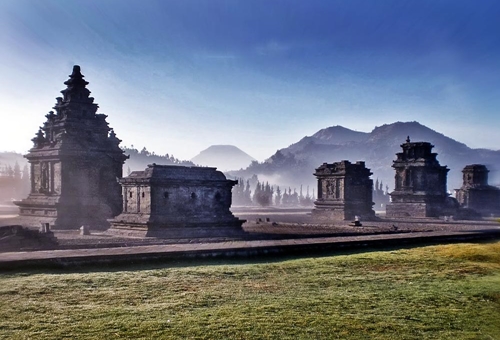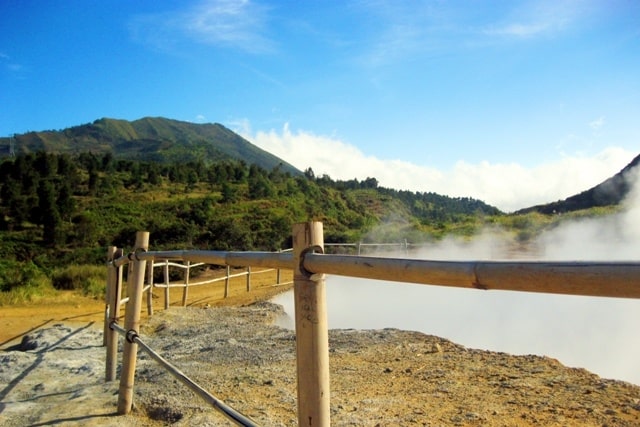Central Java
General Information Central Java Indonesia
Welcome to Central Java, The Culture Wonder.
Located in the middle of the island of Java, the Central Java province is bordered by West and East Java Provinces. Central Java is also located next to Yogyakarta Special Region province. Yogyakarta is historically and culturally part of the Central Java region, although it is now a separate administrative entity.
The average temperature in Central Java is between 18–28 degrees Celsius and the relative humidity varies between 73–94 percent. While a high level of humidity exists in most low-lying parts of the province, it drops significantly in the upper mountains. The highest average annual rainfall of 3,990 mm with 195 rainy days was recorded in Salatiga. The geography of Central Java is regular with small strips of lowlands near the northern and southern coast with mountain ranges in the centre of the region. To the west lies an active stratovolcano Mount Slamet and further east is the Dieng Volcanic Complex on Dieng Plateau. Southeast of Dieng lies the Kedu Plain, this is bordered to the east side by the twin volcanoes of Mount Merapi and Mount Merbabu. South of Semarang, lies Mount Ungaran and to the north-east of the city lies Mount Muria on the most northern tip of Java. To the east near the border with East Java lies Mount Lawu, where its eastern slopes are in the East Java province.
Due to its active volcanic history, volcanic ash makes Central Java highly fertile agriculture land. Paddy fields are extensive, except in the south-eastern Gunung Kidul region partly due to the high concentration of limestone and its location in a rain shadow from the prevailing weather. The largest rivers are the Serayu in the west, which empties into the Indian Ocean, and the Solo which flows into East Java.
History
Java has been inhabited by humans or their ancestors (hominina) since prehistoric times. In Central Java and the adjacent territories in East Java remains known as “Java Man” were discovered in the 1890s by the Dutch anatomist and geologist Eugène Dubois. Java Man belongs to the species Homo erectus. They are believed to be about 1.7 million years old.
Then about 40,000 years ago, Australoid peoples related to modern Australian Aboriginals and Melanesians colonised Central Java. They were assimilated or replaced by Mongoloid Austronesians by about 3000 BC, who brought with them technologies of pottery, outrigger canoes, the bow and arrow, and introduced domesticated pigs, fowls, and dogs. They also introduced cultivated rice and millet. Recorded history began in Central Java in the 7th century AD. The writing, as well as Hinduism and Buddhism, were brought to Central Java by Indians from South Asia. Central Java was a centre of power in Java back then. In 664 AD, the Chinese monk Hui-neng visited the Javanese port city he called Hēlíng or Ho-ling, where he translated various Buddhist scriptures into Chinese with the assistance of the Javanese Buddhist monk Jñānabhadra. It is not precisely known what is meant by the name Hēlíng. It used to be considered the Chinese transcription of Kalinga but it now most commonly thought of as a rendering of the name Areng. Hēlíng is believed to be located somewhere between Semarang and Jepara.
The ninth-century Buddhist monument Borobudur built by the Sailendra.
Borobudur Temple Compounds
The first dated inscription in Central Java is the Inscription of Canggal which is from 732 AD (or 654 Saka). This inscription which hailed from Kedu, is written in Sanskrit in Pallava script.[8] In this inscription it is written that a Shaivite king named Sri Sanjaya established a kingdom called Mataram. Under the reign of Sanjaya’s dynasty several monuments such as the Prambanantemple complex were built. In the meantime a competing dynasty arose, which adhered to Buddhism. This was the Sailendra dynasty, also from Kedu, which built the Borobudur temple. After 820 there is no more mention of Hēlíng in Chinese records. This fact coincides with the overthrow of the Sailendras by the Sanjayas who restored Shaivism as the dominant religion. Then in the middle of the 10th century, for unknown reason, the centre of power moved to Eastern Java.
A few centuries later, after the destruction of the great Hindu Majapahit Empire in the 15th – 16th centuries by the Central Javanese Muslim kingdom of Demak, the Javanese centre of power moved back to Central Java. In the meanwhile European traders began to frequent Central Javanese ports. The Dutch established a presence in the region through their East India Company. After Demak itself collapsed, a new kingdom on the Kedu Plain emerged. This new kingdom, which was also a sultanate, bore the old name of Mataram. Under the reign of Sultan Agung, Mataram was able to conquer almost all of Java and beyond by the 17th century, but internal disputes and Dutch intrigues forced Mataram to cede more and more land to the Dutch. These cessions finally led to several partitions of Mataram.
The first partition was after the 1755 Treaty of Giyanti. This treaty divided the old kingdom in two, the Sultanate of Surakarta and the Sultanate of Yogyakarta. Then few years later Surakarta was divided again with the establishment of the Mangkunegaran after the Treaty of Salatiga (March 17, 1757). During the Napoleonic Wars in Europe, Central Java, as part of the Netherlands East-Indies, a Dutch colony, was handed over to the British. In 1813, the Sultanate of Yogyakarta was also divided with the establishment of the Pakualamanan.
The shattered kingdom, Mataram in 1830, after the Java War.
After the British left, the Dutch came back, as decided by the Congress of Vienna. Between 1825 – 1830 the Java War ravaged Central Java. The result of the war was a consolidation of the Dutch power. The power and the territories of the divided kingdom of Mataram were greatly reduced. Netherlands enforced Cultivation system which was linked to famines and epidemics in the 1840s, firstly in Cirebon and then Central Java, as cash crops such as indigo and sugar had to be grown instead of rice. However Dutch rule brought modernization to Central Java. In the 1900s the modern province of Central Java, the predecessor of the current one was created. It consisted of five regions or gewesten in Dutch. Surakarta and Yogyakarta were autonomous regions called Vorstenlanden (literally “princely states”). Then after the Indonesian independence the province of Central Java was formalized on August 15, 1950, excluding Yogyakarta but including Surakarta.
Since then there have been no (major) changes in the administrative division of Central Java. After the 30 September Movement’s abortive coup of 1965, an anti-communist purge took place in Central Java, in which Communists and leftists (both actual and alleged) were killed by the army and community vigilante groups. Others were interned in concentration camps, the most infamous of which was on the isle of Buru in the Moluccas (first used as a place of political exile by the Dutch). Some were executed years later but most were released in 1979.
In 1998, preluding the downfall of president Suharto, anti Chinese violence broke out in Surakarta (Solo) and surrounding areas. Much Chinese property and other buildings were burnt down. In 1999, public buildings in Surakarta were burnt again by supporters of Megawati Soekarnoputri after the Indonesia parliament chose Abdurrahman Wahid instead of Soekarnoputri to be President of Indonesia. They carried out ‘sweeping actions’ against Western foreigners who reside in this city after the September 11, 2001 attacks.
As of the 2010 census, Central Java's population stood at some 32,380,687. As of the 1990 census, the population was 28,516,786. So the population has increased approximately 13.5% in 20 years. Islam 95.7%, Protestant 1.7%, Catholic 3.2%, Hindu 0.08%, Buddhist 0.64%, dan Kejawen 0.33%.Central Java is considered to be the heart of the Javanese culture. Home of the Javanese courts, Central Javanese culture formed what non-Javanese see as the "Javanese Culture" along with it stereotypes. The ideal conducts and morals of the courts
| 2 Days Borobudur - Dieng |
Program :
Day 1 : Yogyakarta - Borobudur - Nepal Van Java - Wonosobo (L)
Day 2 : Dieng temple - Sikidang Crater - Color lake view from hill - Yogyakarta (B,L)
Inclusion :
- Private Car all inc
- Hotel 1 Night
- Entrance fees and activities/sightseeing/explore
- Tourist guides
- Meals mentioned
- Mineral water
Price (Min 2 pax) : USD 228 / pax
| 3 Days Borobudur - Dieng - Semarang |
Program :
Day 1 : Yogyakarta - Borobudur - Nepal van Java - Wonosobo (B)
Day 2 : Dieng temple - Sikidang Crater - Color lake view from hill - Semarang (B,L)
Day 3 : Sam Poo Kong temple - Lawang Sewu old building - Semarang Old town - transfer to Yogyakarta (B,L)
Inclusion :
- Private Car all inc
- Hotel 2 nights
- Entrance fees and activities/sightseeing/explore
- Tourist guides
- Meals mentioned
- Mineral water
Price (Min 2 pax) : USD 343 / pax
| Plan your trip with us |


